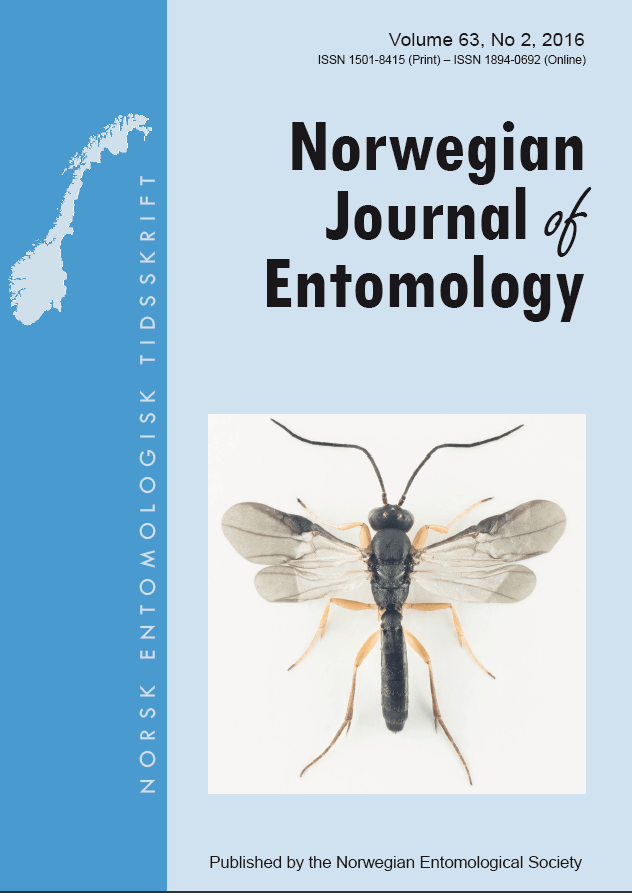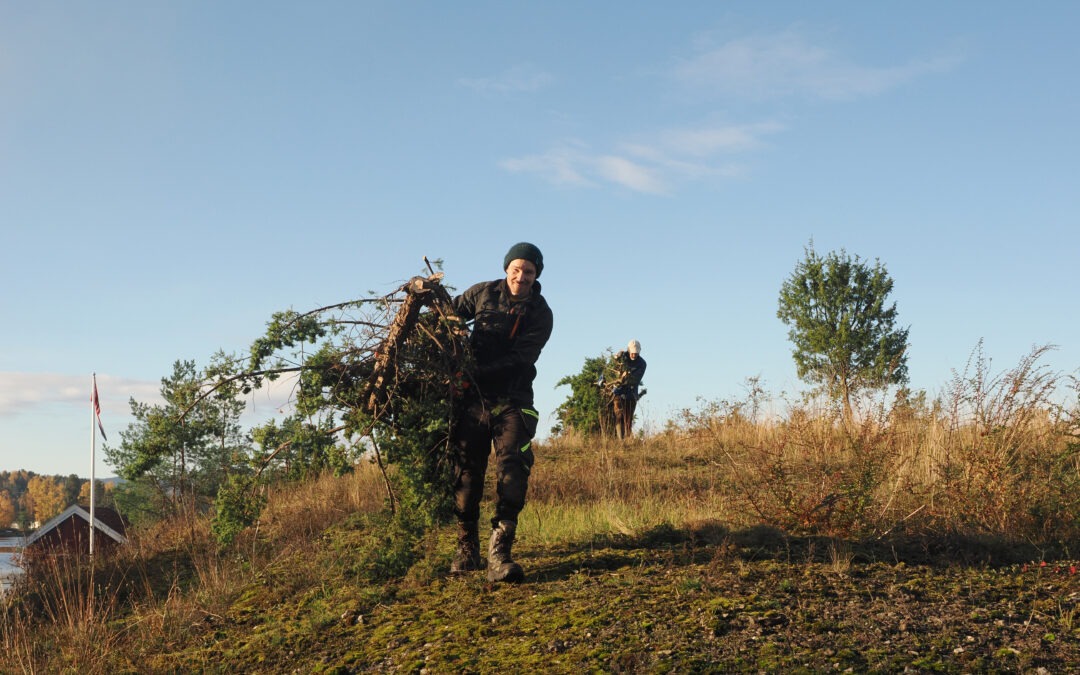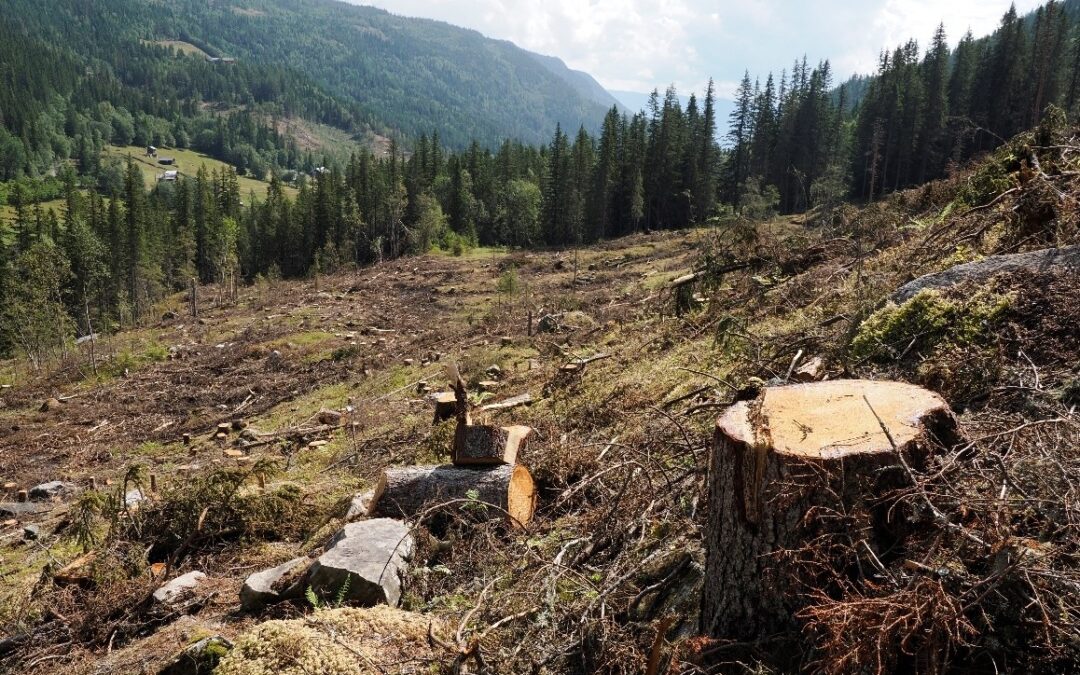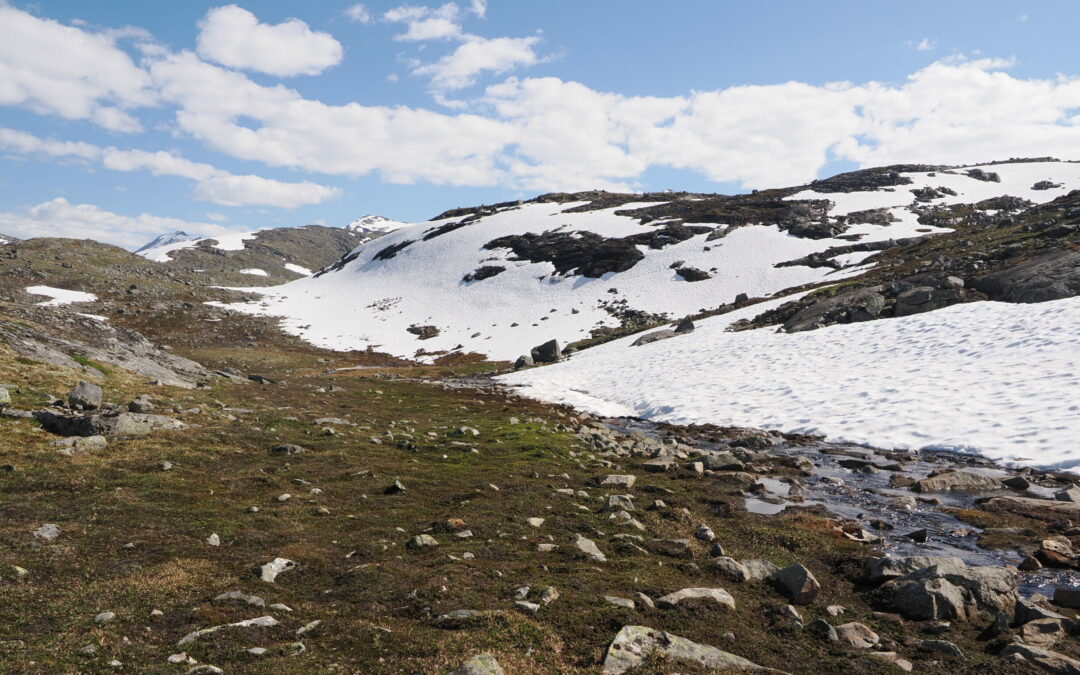Norwegian Journal of Entomology vol. 63-2 ble trykket 12. desember og er på vei til abonnentene.
Årets første utgave av tidsskriftet vil også bli tilgjengelig på www.entomologi.no
I denne utgaven av Norwegian Journal of Entomology kan man lese følgende artikler:
Forshage, M., Hanssen, O. & Staverløkk, A. 2016. Platyceraphron Kieffer, 1906 (Hymenoptera, Megaspilidae) in the Nordic countries. Norwegian Journal of Entomology 63, 125–129.
The genus Platyceraphron Kieffer, 1906 with the species P. muscidarum Kieffer, 1906 is reported as new to Norway, caught in traps at two different locations. An old Swedish record which seems to have been forgotten is reviewed and one recent Swedish record added. No records are known from Finland and Denmark. Platyceraphron are remarkably dorsoventrally flattened wasps, and have been reported as parasitoids of subcorticeous flies, mainly Lonchaeidae.
—
Kvamme, T. & Wallin, H. 2016. Corrigenda to “Biological notes and distribution of Leiopus Audinet-Serville, 1835 (Coleoptera, Cerambycidae) in Norway”. Norwegian Journal of Entomology 63, 130.
Kvamme & Wallin (2013) presented the distribution of Leiopus nebulosus (Linnaeus, 1758) and L. linnei Wallin, Nylander & Kvamme, 2009, in Norway. Observations of host trees as well as information of substrate qualities and phenology are also included. Due to a mistake two headings were misplaced in the text, which led to some confusion.
—
Hofsvang, T. 2016. The Norwegian species of Dolichopezinae, Ctenophorinae and Angarotipula, Nephrotoma, Nigrotipula and Prionocera (Tipulinae) (Diptera, Tipulidae). Norwegian Journal of Entomology 63, 131–139.
The distribution in Norway of the species in the following genera of Tipulidae is surveyed: Dolichopeza Curtis, 1825, Ctenophora Meigen, 1803, Dictenidia Brullé, 1833, Phoroctenia Coquillett, 1910, Tanyptera Latreille, 1804, Angarotipula Savchenko, 1961, Nephrotoma Meigen, 1803, Nigrotipula Hutson & Vane-Wright, 1969 and Prionocera Loew, 1844. Notes on the flight period and habitats are also given.
—
Falkegård, M., Elliott, J.M. & Klemetsen, A. 2016. Major factors affecting the diversity of aquatic insects in 13 streams with contrasting riparian vegetation in the river Tana, North Norway. Norwegian Journal of Entomology 63, 140–158.
hBenthic invertebrate samples, taken in August and October 2000, 2001, 2002 at three sites in each of 13 streams (total 39 sites over a 200 km stretch of river), were used to: (i) classify the species/taxa into groups according to their occurrence; (ii) compare species/taxa richness and biodiversity across all sites; (iii) detect environmental variables responsible for differences between sites. Of 87 recorded taxa, 79 were aquatic insects, 19 were common to 12 streams, 19 were rare (found in ≤2 streams), and the remaining 49 were found in most, but not all, streams in both months. Multivariate analysis separated the latter 49 taxa into benthic assemblies flowing through: (i) willow forest; (ii) non-forested alpine habitat; (iii) birch (October only); (iv) birch and mixed birch-pine (August only); (v) mixed birch-pine habitat (October only). Multiple regression evaluated the relationships between 12 environmental variables and: (i) the residuals from a power function relating benthic density and variation in number of taxa among sites; (ii) Simpson and Shannon-Wiener diversity indices. Overhanging cover and stream width affected positively the larger number of species/taxa and diversity in August, with diversity also affected positively by moss cover. In both months, instream cover had a positive, and water velocity a negative, effect on species/taxa richness, whilst their effects on diversity were the exact opposite. The importance of overhanging and instream cover in this study has sown that enhancing riparian vegetation should always be an important factor in stream restoration and conservation projects.
—
Kvamme, T., Bezděčková, K. & Bezděčka, P. 2016. Interesting records of ants and Lasius alienus (Förster, 1850) (Hymenoptera, Formicidae) presented new to Norway. Norwegian Journal of Entomology 63, 159–163.
A colony of Lasius alienus (Förster, 1850) was found close to the harbour in Trondheim City in 2014. The species was expected to occur in Norway, but not as far north. It cannot be excluded at the moment that the colony is a result of introduction by human activity. L. alienus is species number 66 documented as outdoor living species in Norway. Additional records of Temnothorax nylanderi (Förster, 1850) and Leptothorax gredleri Mayr, 1855 from Norway are presented.
—
Andersen, T. 2016. A new species of Litocladius Mendes, Andersen & Sæther, 2004 from the Amazon rainforest, Brazil (Diptera, Chironomidae, Orthocladiinae). Norwegian Journal of Entomology 63, 164–168.
Litocladius joergeni sp. n. is described and figured based on a male collected in a Malaise trap in the Reserva Adolpho Ducke near Manaus in Amazonas. The new species can be separated from its congeners by the combination of having an apical spine on third palpomere, wing with setae only on vein M1+2 and in cell r4+5, a subquadrangular inferior volsella with several strong setae and a very long, complex virga surrounded by strong lamellae.
—
Nielsen, T.R. 2016. Records and notes on some Oriental Platycheirus species and description of the female P. himalayensis Brunetti, 1915 (Diptera, Syrphidae). Norwegian Journal of Entomology 63, 169–174.
The paper reports on six Platycheirus Le Peletier & Serville, 1828 species from the Oriental region. The female of P. himalayensis Brunetti, 1915 is described and figured, and a key is given to separate the species from the similar P. manicatus (Meigen, 1822).
—
Endrestøl, A., Olsen, K.M. & Gustad, J.R. 2016. Two introduced species of Typhlocybinae (Hemiptera, Cicadellidae) new to Norway. Norwegian Journal of Entomology 63, 175–183.
This paper present two species of Typhlocybinae (Hemiptera, Cicadellidae) new to Norway, Zonocyba bifasciata (Boheman, 1852) and Zyginella pulchra Löw, 1885. Both species are reported from plant importers and from established populations in Norway. We argue that both species have been introduced into Norway as hitchhikers on garden plants, but that we cannot rule out the possibility of a simultaneously range expansion into Norway from Sweden.
—
Olberg, S. & Wergeland Krog, O.M. 2016. Allecula rhenana (Bach, 1856) (Coleoptera, Tenebrionidae) in Norway. Norwegian Journal of Entomology 63, 184–187.
The darkling beetle Allecula rhenana (Bach, 1856) is reported for the first time from Norway. In July 2016, one female of A. rhenana was caught in a window trap mounted on an old hollow oak (Quercus robur) at Ø, Fredrikstad: Brevik. The beetle community connected with ancient oaks have been mapped with a considerable intensity for the last decade compared to earlier times, but still, new species to the Norwegian fauna are discovered.
—
Staverløkk, A. & Ødegaard, F. 2016. New records of parasitic Hymenoptera associated with ants, including five new species to Norway. Norwegian Journal of Entomology 63, 188–196.
This paper present the first records of Paralipsis enervis (Nees, 1834) (Braconidae, Aphidiinae), Neoneurus clypeatus (Foerster, 1862), Elasmosoma luxemburgense Wasmann, 1909, Elasmosoma berolinense Ruthe, 1858 (Braconidae, Euphorinae) and Hybrizon buccatus (de Brébisson, 1825) (Ichneumonidae, Hybrizoninae) new to Norway. Paralipsis enervis is associated with root aphids in nests of the ant Lasius niger (L., 1758). Neoneurus clypeatus is a primary parasitoid of Formica rufa sensu lato, and Elasmosoma luxemburgense is a primary parasitoid of Formica rufibarbis Fabricius, 1793. New records and new host associations of Neoneurus auctus (Thomson, 1895), and Hybrizon buccatus are reported. A short review of each species biology is given.
—
Lissner, J., Jensen, J-K., Hansen, L.J., Simonsen, W., Kelduni, R. & Nissen, K. 2016. An updated checklist of spiders (Araneae) of the Faroe Islands. Norwegian Journal of Entomology 63, 197–240.
This study updates the previous checklist of Faroese spiders published in 2004. Fifteen species are added to the list: Amaurobius fenestralis (Ström, 1768), A. similis (Blackwall, 1861), Zygiella x-notata (Clerck, 1757), Allomengea scopigera (Grube, 1859), Baryphyma trifrons (O. P.-Cambridge, 1863), Erigone dentigera O. P.-Cambridge, 1874, E. whymperi O. P.-Cambridge, 1877, Halorates reprobus (O. P.-Cambridge, 1879), Microlinyphia pusilla (Sundevall, 1830), Porrhomma campbelli F.O.P.-Cambridge, 1894, P. pallidum Jackson, 1913, Silometopus ambiguus (O. P.-Cambridge, 1905), Psilochorus simoni (Berland, 1911), Tetragnatha extensa (Linnaeus, 1758), and Parasteatoda tepidariorum (C.L. Koch, 1841). Nine species are deleted from the checklist. While Araneus diadematus Clerck, 1757, A. quadratus Clerck, 1757, and Nuctenea umbratica (Clerck, 1757) have been repeatedly introduced to the Faroes they have failed to establish and are deleted. Crustulina guttata (Wider, 1834) and Walckenaeria obtusa Blackwall, 1836 are considered accidental imports unable to breed in the islands and are also deleted. Bolephthyphantes index (Thorell, 1856) and Tmeticus affinis (Blackwall, 1855) are assumed erroneously reported from the islands and are deleted from the list along with Agyneta ramosa Jackson, 1912 and Ozyptila atomaria (Panzer, 1801) which were found to be misidentified upon re-examination of museum specimens. The status of Porrhomma egeria Simon, 1884 in the Faroes is uncertain and is maintained on the list. At least 114 spider species have been recorded in the Faroes, however only 90 meet the criteria of the checklist.




